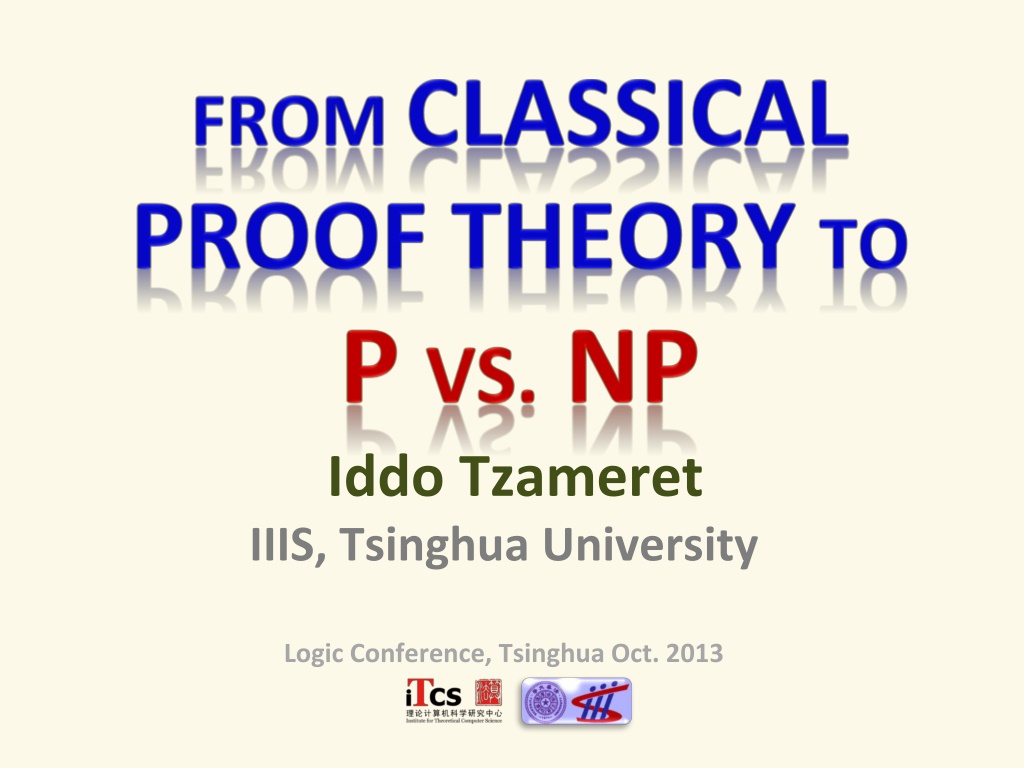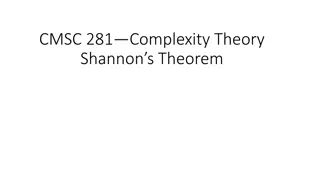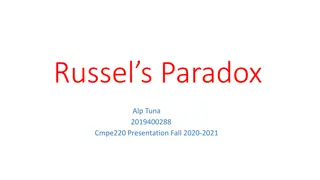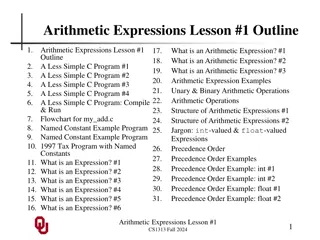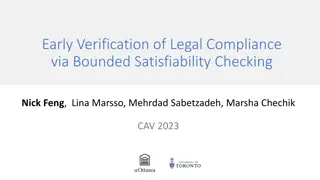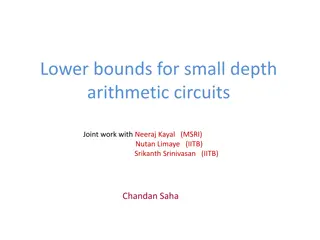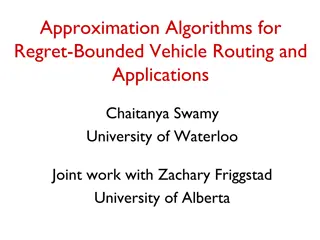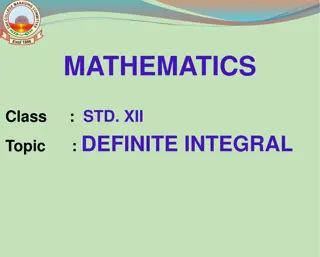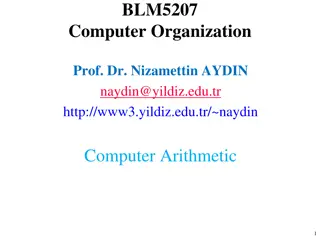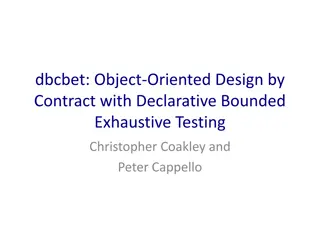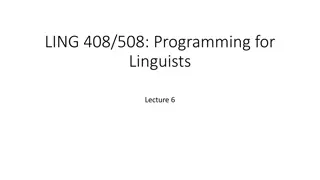Understanding Bounded Arithmetic and Definable Functions in Complexity Theory
Bounded arithmetic, as explored in complexity theory, focuses on theories like PA but with restrictions on formulas. The comprehension axiom determines sets that can exist, and TC is a first-order arithmetic theory defining functions within a specific complexity class. The witnessing theorem in TC establishes the definability of functions. By delving into these concepts, one can grasp the essence of string functions that can be proven to exist within such frameworks.
Download Presentation

Please find below an Image/Link to download the presentation.
The content on the website is provided AS IS for your information and personal use only. It may not be sold, licensed, or shared on other websites without obtaining consent from the author. Download presentation by click this link. If you encounter any issues during the download, it is possible that the publisher has removed the file from their server.
E N D
Presentation Transcript
Iddo Tzameret IIIS, Tsinghua University Logic Conference, Tsinghua Oct. 2013
Complexity Theory P = PTIME: Efficiently computable problems; Algorithms of polynomial run-time Example: Input: a proof in Peano Arithmetic (PA) Output: output yes iff the proof is correct. NP: Non-deterministic polynomial time; Problems whose solutions are efficiently verifiable Example: Input: a number k in unary and a statement S in the language of PA Output: yes if exists a PA proof of S of k number of symbols
Formal Theory of Arithmetic X(i)=1 iff i-th bit in string X is 1 Formally: range over finite sets of numbers, encoding binary string: {0,2,5} encodes string 10101 Length of string Beginning with Peano Arithmetic For convenience: Two-sorted theory: 1. Number sort: String sort: 2. Language: 3. Logical connectives: Quantifiers: 4. Axioms for the symbols Example of axioms: , ,
Formal Theory of Arithmetic y |X| -Comprehension Axiom: for a set of formulas: for in . Determines what sets provably exist in the theory If is set of all formulas: gives us too much power ! Parikh 1971: What if we restrict ? Restriction: = = set of formulas with only bounded number quantifiers (i.e., no string quantifiers) Example: X is a (binary) palindrome:
Bounded Arithmetic So we get: PA, except that axioms assert only the existence of finite sets definable with formulas (formulas with no string-quantifiers and with bounded number-quantifiers.) Such formulas correspond to a (weak) complexity class: constant-depth Boolean circuits of polynomial-size (aka AC0). Denote this class C. And the theory TC First-order theory of arithmetic; Axioms state the existence of finite sets defined by class C. What kind of (string) functions essentially exist in our world?
Definable Functions of TC What kind of functions our theory TC can (essentially) prove to exist? When do we say that a theory can prove the existence of a function f(X) (aka, a provably total function in the theory) ? For simplicity: only string inputs to function (There is a reason we require ; otherwise things become not interesting\useful) Witnessing Theorem: A function is definable in TCif and only if a function is in complexity class C.
Witnessing Theorem for TC Witnessing Theorem: A function is definable in TC if and only if a function is in complexity class C. Proof: ( ) This is not very hard. The interesting part: ( ) Assume is a definable function in TC. We want to show it is in complexity class C. Herbrand Theorem: Let T be a universal theory and let be a quantifier-free formula such that: , then there are finitely many terms in the language All axioms are universal (all quantifiers are appering on the left). such that:
Proof of Witnessing Theorem for TC Need to show: if and Then defines a function from C. Herbrand Theorem: Let T be a universal theory and let be a quantifier-free formula, such that: Then there are finitely many terms in the language such that: . To apply Herbrand Theorem (and conclude Witnessing Theorem) we need: 1. TC is universal theory 2. Make sure all terms in language describe functions from C; 3. We can assume TC is not universal. But we can add new function symbols and take out some axioms to get a universal theory that is a conservative extension of TC We add function symbols (with defining axioms) in C. And the C-closure of all functions is C itself.
Some Credits Bounded Arithmetic: Parikh 71, Cook 75, Paris & Wilkie 85, Buss 85, Kraj ek 90s, Pudl k 90s, Razborov 95, Cook & Ngyuen 10 Krajicek Nguyen Paris Buss Cook Pudlak Wilkie Razborov
Polynomial-Time Reasoning Go beyond TC : add axiom stating the existence of a solution to a complete problem for P: P-Axiom: The gates of a given monotone Boolean circuit with specified inputs can be evaluated Obtain the theory VP for ``polynomial time reasoning . Witnessing Theorem for VP: the same as before, but now a function is definable in the VP iff it is a polynomial-time function!
Propositional Translation True formulas family of propositional tautologies formula Let be a formula. If is true for every string length (in standard model ) Then the propositional translation of is a family of tautologies:
From First-Order Proofs to Propositional Proofs Translation Theorem: If and then has polynomial-size propositional proofs. Propositional Proof: (Hilbert style + extension rule = Extended Frege): Start from some axioms, and successively apply inference rules to derive new formulas
Propositional Proofs THEOREM: If there exists a family of tautologies with no polynomial size Propositional Proofs, then: it is consistent with the theory that I.e., There is a model of VP where P NP. Note: experience shows most contemporary complexity theory is provable in VP Proof idea. Assume by a way of contradiction that it is inconsistent with that Then . . I.e., you can t prove in polynomial-time reasoning that P=NP. Hence, Then, by Translation Theorem there are polynomial-size propositional proofs of . Since the set of TAUTOLOGIES is coNP, , there are polynomial-size propositional proofs for all tautologies. Contradiction. .
Conclusion We ve seen one reason why proving super- polynomial lower bounds on propositional proofs (Extended Frege) is a very important and fundamental question. Currently only linear (n) lower bounds are known on size of Extended Frege proofs! Possibly feasible: super-linear lower bounds (n ), for 1> >0. My work on related issues: algebraic analogues of these questions. Have more structure.
